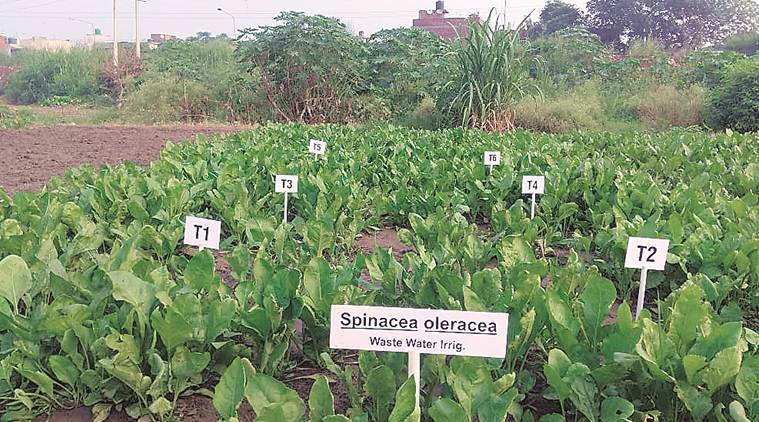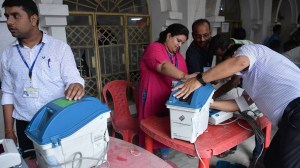- India
- International
These greens, veggies are ‘slow poison’
The study has found heavy metal contamination in the vegetables irrigated with waste water from Buddha Nullah in Ludhiana.
 At least 60 per cent of 200 persons who have been consuming these veggies and were surveyed, were found suffering from at least one disease.
At least 60 per cent of 200 persons who have been consuming these veggies and were surveyed, were found suffering from at least one disease.
For those who love their leafy greens and farm fresh vegetables, here’s some bad news. If you’ve been consuming the vegetables grown along the banks of Buddha Nullah, you better rush to a doctor for a medical check-up. Chances are you might be suffering from at least one disease caused by heavy metals.
Sounds ominous? This is what a research study by a PhD scholar and an associate professor at the Lovely Professional University, Phagwara, has found.
The study – ‘Bioaccumulation of heavy metals and biochemical changes induced in vegetables irrigated by waste water at Buddha Nullah agricultural sites (Punjab)’ – has found heavy metal contamination in the vegetables irrigated with waste water from Buddha Nullah in Ludhiana.
At least 60 per cent of 200 persons who have been consuming these veggies and were surveyed, were found suffering from at least one disease – kidney failure, premature births, skin allergies, breast and gastrointestinal cancer, heart diseases and mental disorder – caused by heavy metals.
Jagdev Singh, PhD scholar in botany who along with Dr Anand Mohan, Associate Professor, department of biosciences and bioengineering, LPU, conducted the study, said, “The heavy metal concentration in vegetable grown along Buddha Nullah was found at least 10 times more than permissible limits. Also, more persons consuming these vegetables (irrigated with waste water from nullah) were found suffering from related diseases than those consuming vegetables grown in normal fields irrigated with normal bore water.”

The study concluded that “the regular consumption of vegetables grown near Buddha Nullah can cause detrimental effects to the human population. The consumption of leafy and root vegetables from the fields near Buddha Nullah should be restricted and continuous monitoring of vegetables from these sites should be done”.

Jagdev Singh said that over a period of two years, random samples of four vegetables – radish (root), tomato (fruit), caulifower (stem) and spinach (leafy) – were taken from the fields on Buddha Nullah road (near Mota Singh Nagar where at least 45 farmers grow vegetables).
The heavy metal content in the samples was compared to vegetables irrigated with normal water. Also, two groups of 200 persons – one consuming the vegetables irrigated with Buddha Nullah water and the other with normal water – were surveyed. “To have one controlled sample, I also cultivated a field along the Nullah and irrigated it with polluted water,” he added.
“At least 60 per cent of 200 persons, which included families of some farmers, were found suffering from at least one disease whereas prevalence of diseases was much lower (20 per cent) among population consuming veggies grown away from Buddha Nullah,” he said. Also, the heavy metal content in veggies grown away from Buddha Nullah was found below than permissible limits, he added.
The study found 11.80 milligram/kilogram (mg/kg) of cadmium, 29.6 mg/kg of chromium and 7.10 mg/kg of lead in radish grown near the Nullah. The cauliflowers grown near the nullah were found having 6.80 mg/kg cadmium, 7.2 mg/kg chromium and 2.5 mg/kg lead. The tomatoes had 6 mg/kg cadmium, 6.8 mg/kg chromium and 2.3 mg/kg lead. The spinach leaves grown near nullah had the highest 12.5 mg/kg cadmium, 16 mg/kg chromium and 4.5 mg/kg lead.
This is way higher than the permissible limits of 0.10 mg/kg cadmium, 0.50 mg/kg chromium and 0.50 mg/kg lead, as specified by the World Health Organization (WHO).
The heavy metal concentration in the waste waters of Buddha Nullah which is used for irrigating these veggies, was: Arsenic 0.08 milligram/litre (mg/l), Cadmium : 0.98 mg/l, Chromium: 3.02 mg/l and Lead : 0.3 mg/l whereas the permissible levels are Arsenic : 0.01 mg/l, Cadmium : 0.03 mg/l, Chromium : 0.05mg/l and Lead : 0.01 mg/l. (as per WHO).
The black waters of 14-kilometer heavily polluted stream, carrying untreated industrial effluents, domestic sewage waste and solid waste, passing from Ludhiana city, mix with clean waters of river Sutlej at village Walipur Kalan.
Reality-check: A dirty stream and an unfulfilled promise
The 14-km stream running through the industrial city Ludhiana, carries waste from dyeing units, domestic sewage waste and garbage dumped by people. This further pollutes river Sutlej, which even farmers from Rajasthan have objected to.
Further, most projects announced to clean it have remained on paper. The latest attempts include the Special Task Force (STF) formed by Captain Amarinder Singh under Namdhari sect head Thakur Uday Singh along with roping in of the Tata group by Ludhiana MP Ravneet Singh Bittu. However, on the ground, all that Ludhiana Municipal Corporation is doing is the annual de-silting to clear choked stream during monsoons for which just Rs 1 crore is kept in annual MC budget. Finance Minister Manpreet Badal also announced sum of Rs 4.38 crore in 2019-20 budget to clean it but superintending engineer, MC, Ravinder Garg said, “We have not received any funds other than annual de-silting budget.”
The National Green tribunal (NGT) monitoring committee, formed in April 2019 to monitor pollution in Sutlej and Beas, is expected to start real-time quality check soon, as told by the Punjab Pollution Control Board (PPCB) to Punjab and Haryana High Court.
Apr 19: Latest News
- 01
- 02
- 03
- 04
- 05






































